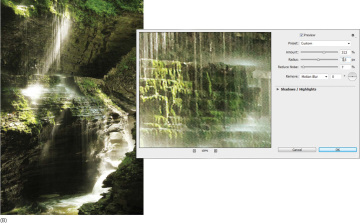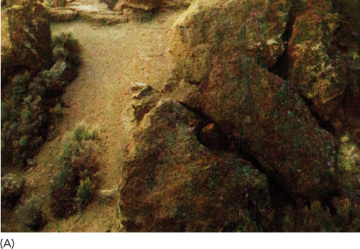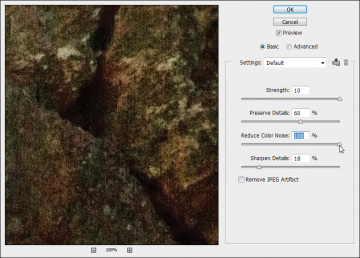Featured Filters
Somewhat related to adjustment layers are filters that can be applied to a layer. Both filters and adjustment layers can dramatically alter the look and feel of an image, helping with seamlessness or adding a nice visual effect. Filters don’t have a dedicated panel though, and instead live within the Filter menu (see Figure 4.1). Although many of the filters by themselves end up looking too canned and obvious for most uses, there are the few described in the next sections that stand out as invaluable for composite work. Filters such as Smart Sharpen and Reduce Noise can help with quality differences and, like color adjustments, help match images from different sources. Blurs also come in handy as an effect when you need more control of the depth, mood, or motion. In Chapter 9, you’ll use them to create sunrays, while Bonus Chapter 16 demonstrates using filters to soften glare.
Smart Sharpen
What makes the Smart Sharpen filter smart is its ability to control simultaneously the amount of sharpening, noise reduction (Photoshop CC), and compensation for various kinds of blur, from motion blurs to lens blurs (FIGURE 4.10). This combination of strengths is more versatile than other sharpening methods (like Unsharp Mask) and is very useful when you need to match one picture element to another, as illustrated in Chapter 14.

FIGURE 4.10 Smart Sharpen enables you to compensate for multiple kinds of blur and gives you greater flexibility than other sharpening methods.
When using Smart Sharpen, either on ordinary layers or as a Smart Filter on Smart Objects, keep a few tips in mind:
- Avoid halos created from too large a Radius and too high an Amount of sharpening applied. This not only looks bad, but it’s a tell-tale sign of amateur sharpening or that you did not zoom in close enough to see what was happening. When the radius size is larger than the blurriness you start to increase the contrast for parts that you shouldn’t be increasing, parts that don’t need it. Combine this with a sharpening amount that goes a bit overboard, and you have yourself a mighty halo on the outside of your edges. Start with a radius that matches the blur radius (typically 1 to 3 pixels for my own setup), then boost the Amount slider until edges pop without a dramatic light halo. For Photoshop CS6 and older versions, this usually meant under 100%, but the CC version of this feature can easily push to 300% without overly adverse effects.
- Zoom in close to see what’s being sharpened and what the effects are in regards to halos and noise, then zoom out to make sure it’s actually having a good sharpening effect in a general sense. It’s always a balance of too much and creating bad halos versus not enough and having very little sharpening taking place.
- Click and hold on the Preview image to the left of the sliders to see its original state, then release to see the effect of the current Smart Sharpen settings. This is great for toggling a fast before-and-after comparison.
- Use the Remove drop-down menu to specify the type of blur you’re trying to remove. In most cases, the Gaussian or Lens Blur setting works best. When you need to sharpen away some camera motion, choose Motion Blur and set the Rotation dial angle using the line running through the center as a reference for the direction the motion blur is smearing (this fills in the Angle field automatically). From there, adjust the Amount slider until motion is looking a little more stationary (FIGURES 4.11A and B). Note that this does not perform miracles on unholy amounts of motion blur—it’s smart, not omnipotent.
FIGURES 4.11A and B Fix mild motion blur with the motion blur removal option; set your angle that the blur is smearing, and work with the Amount slider until satisfied. Compare the results (b) with the original image (a), which contains a small amount of diagonal motion blur as I didn’t have a tripod with me.
Reduce Noise
When compositing images from sources of noticeable quality and other differences, the Reduce Noise filter is one more handy tool in your seamless editing belt. Consistency is important for overall continuity and making those puzzle pieces blend without a trace is the challenge. Digital noise is often a hidden trip wire in underexposed images. Noise is a term used for randomized bits of unwanted visual static. Noise occurs from taking pictures that have boosted the amplitude of the sensor’s signal (results of a higher camera ISO), usually for low light situations (Chapter 5 discusses this in more detail).
There’s not a whole lot to this filter, but the Reduce Noise filter does help with this noise challenge by leveling out some of the bits of contrast and static generated from sharpening a grainy image or getting rid of high camera ISO complications. Typically though, I use this filter for concentrating just on color noise (what I find to be the most important part to focus on), randomized bits of color in particular, as those are easy enough to get rid of without too many consequences such as blurring the layer (FIGURES 4.12A and B).
FIGURES 4.12A and B The Reduce Noise filter works especially well for terrible color noise generated from lightening an underexposed or high-ISO image; here you can see the color noise in the lightened shadows of the rocks (a) being reduced (b).
Blurs
Ever notice a full sense of depth created from an image using a shallow depth of field? Some parts of the image blur as they get closer or further away. The tendency to focus our attention in just the right areas and create a sense of depth or motion are particularly helpful abilities of the various blur filters. Ever try to simulate a longer exposure with a motion blur? Photoshop CC and CS6 come with some fantastic blurs for a wide range of uses, from simulating tilt-shift lenses to natural-looking lens blurs (FIGURE 4.13).

FIGURE 4.13 Three blurs living under one roof is a helpful feature for getting just the right blur to an image.
The Three Latest Blurs
The three newest blur filter additions, the Tilt-Shift Blur, Iris Blur, and Field Blur, are linked together within the same dialog window and offer a wide range of control and blurring effects. The most powerful and useful for my own workflow is the Radial Blur, but here’s a little information about each:
Tilt-Shift Blur provides a nice mirrored gradient transition of blurring, much like the shallow depth of field when shooting something small, such as a miniature model set. This can be a nice effect for those images with easy to see distances and without obstructions (FIGURE 4.14).

FIGURE 4.14 Tilt-Shift provides an interesting miniature look to an image making even the largest vistas feel more like a macro shot.
- Field Blur enables you to change the blur and sharpness. Very similar to the traditional Gaussian blur filter, Field blur allows you to set multiple blur pins each with their own amount of blur controlled independently. This is especially valuable for moments of variable blurring of a layer—such as an actual field blur simulation.
- Iris Blur is similar to the Field blur, but one-ups it with control and some added slick features. Rather than giving a general blur (like Field blur) and a location to apply it, this blur lets you shape it as an oval! You can set both the iris radius (oval size) and orientation while also indicating the area it begins to transition from sharp to blurry (FIGURE 4.15). When working with Iris blur you can also edit multiple features just within the preview area. For example, click and hold the default center focus pin to drag it to a new location, or you can add additional focus pins by clicking elsewhere in the image. Click the outer blur area ring to expand and rotate the Iris radius where the full amount of the blurring pixel radius is applied in force (FIGURE 4.16). The four middle points help you adjust the inside ring that stays absent of blur (called the Sharp area).

FIGURE 4.15 The Iris Blur filter lets you control where blur starts and how dramatic the transition is from being sharp to the full blur amount (set by the Radius slider).

FIGURE 4.16 Iris Blur is wonderfully versatile as you can control the location of the blur, the severity of the blur, and several other customized options, as well as having multiple blur locations all on one layer.
Filter with Camera Raw Editor
The Camera RAW Editor enables you to make nondestructive adjustments on RAW images for everything from color temperature, lights and shadow, clarity, to specialized curves and other color control elements. Chapter 5 will highlight some of the key features of editing in RAW, but no discussion of useful filters would be complete without mentioning you can use the Adobe Camera Raw (ACR) Editor as a Smart Filter (FIGURE 4.17).

FIGURE 4.17 The Camera RAW editor is unparalleled as the newest Smart Filter; all the sliders and editing interface combined with the potential of working in Photoshop’s layer environment—just brilliant.




